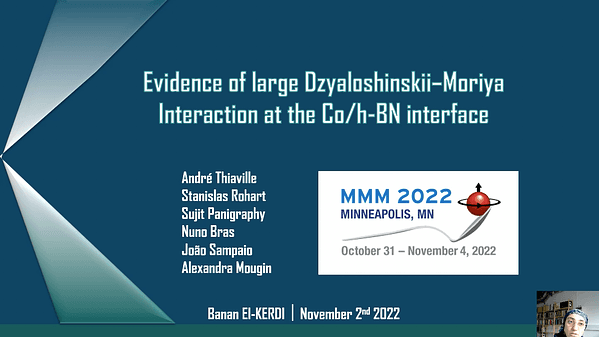Would you like to see your presentation here, made available to a global audience of researchers?
Add your own presentation or have us affordably record your next conference.
Over the last decade, quantum systems offering new computational and sensing capabilities have emerged 1. One of these promising hybrid systems involves the
interaction between photons and magnons. This interaction is quantitatively known by the strength coupling g and furthermore by its ratio with the cavity frequency g/ω. It exists three
different domains of this ratio: the Strong Coupling (SC) for g/ω < 0.1; the Ultra-Strong Coupling (USC) for 0.1 < g/ω < 1; and the Deep-Strong Coupling (DSC) for g/ω > 1. One of the
objectives of this last decade is to achieve the USC, and to approach the DSC 2. A few experimental works already exist on the USC regime 3 and it is still complicated to understand
the different Hamiltonian approximations used to fit experimental data 2. Here, we present a tuneable hybrid system which makes possible experimental observation of a coupling regime
from strong to ultra-strong at room temperature (RT).
The hybrid system presented here is made of a double re-entrant cavity and a commercial single crystal of YIG (see Fig. 1). It is possible to tune the ratio g/ω with decreasing the gap
between the top of pillars and cavity which will decrease ω without changing g. We optimized two different cavities considering two YIG shapes (sphere and slab). These two cavities work in the USC regime, from the SC/USC limit to g/ω = 0.6. One of these measures
is presented in Fig. 2 where is shown the S21 parameter according to a sweep on RF frequencies and the static H-field. With the use of Finite Element Modelling, we were able to follow the
coupling strength from the SC to the USC domains and were in a good agreement with measurements. We observed that the standard Hamiltonians (Dicke and Hopfield) do not describe
our system. With modifying the Dicke model with adding a frequency shift ωΔ on the FMR, we were able to fit measures and simulations. It should be noted that this added term is
proportional to g2/ω.
We demonstrated the capability of a 3D magnonic cavity to work in the USC regime and its tuneability
with playing with the gap. To reach the DSC, it will be interesting to work on other cavity shapes to have a bigger ratio g/ω.
References
1 D. Lachance-Quirion, Y. Tabuchi, A. Gloppe, Appl. Phys. Exp., vol. 12, p. 070101 (2019)
2 I.A. Golovchanskiy, N.N. Abramov, V.S. Stolyarov, Phys. Rev. Applied., vol. 16, p. 034029 (2021)
3 A.F. Kockum, A. Miranowicz, S. De Liberato, Nat. Rev. Phys., vol. 1, p. 19-40 (2019)

Fig. 1: Machined cavity

Fig. 2: Spectral transmission S21
